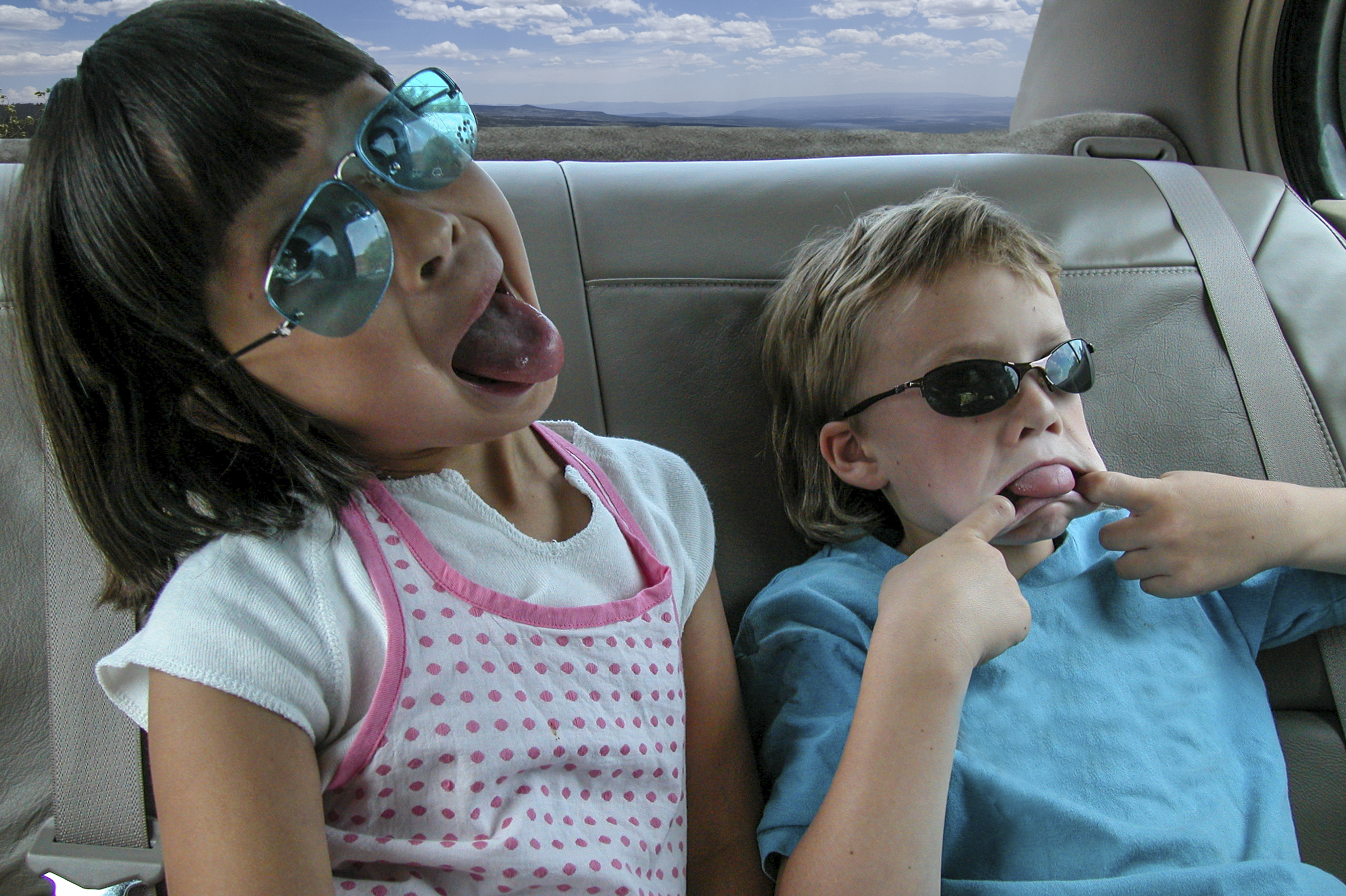
Mason: “I wonder what Mrs. Jones will be like. Is she strict?”
Savannah: “She’s mean. All the kids say so.”
Mason: “Oh, no! I hope she’ll like me.”
Savannah: “She won’t. Nobody likes you.”
Mason: “They do, too! Last year, Mrs. Wright liked me!”
Savannah: “That’s because you’re a goody two-shoes. And they don’t really like you.”
Mason: “Mom! Do people like me?
Mom: “Of course they do, Mason. Savannah, stop being mean to your brother. Let’s everybody be nice and have a nice drive to the first day of school.”
Savannah: “I’m just telling the truth.” (Makes a nasty face at Mason)
Mason: “You meany!” (Shoves at Savannah)
Savannah: “Mooommmmm! He hit me!”
Mom (Yelling): “Okay, that’s it! No ipad later for either of you. And no more talking! If you can’t say anything nice, then don’t say anything at all!”
Before you know it, you’re yelling. By the time they get out of the car, the kids are sullen. Your plans for a peaceful start to their first day of school just evaporated before your eyes. Backseat bickering can completely ruin your morning.
Luckily, there are things you can do to turn the tide when the tone gets tense in your car. Let's rewind this script, but first, our guiding principles:
1. Calm yourself.
It’s natural to get angry when your children are mean to each other. But indulging your temper just inflames the storm. Instead, remember that your goal is restore a sense of safety for both children. So take a deep breath and remind yourself that there’s no emergency. Your tone will be warmer and more soothing, which gives you a chance to calm the storm.
2. Connect with both children, using empathy.
Most of the time, kids bicker when they’re worried, bored, or still mad about something that happened previously. If you address the reason, you can stop the fight before it starts.
3. Set limits and enforce family rules about kindness.
Every home needs a few clear rules about how people in the family treat each other, and “We’re kind” is one of the most important. Interrupt unkind remarks to set a clear standard for civility. All children will get mad at each other—conflict is a part of every human relationship—but they can be encouraged to express their needs and wants without attacking the other person. Of course, when you set the limit, stay kind yourself. Children learn from our role-modeling how to handle the problems they have with other people. And they’re more likely to follow your limits if you can stay connected while you set them.
4. When possible, defuse tension by using humor.
When kids are anxious, they tend to lash out. Take the edge off their worry by getting them laughing, which transforms their body chemistry, reducing stress hormones and increasing “feel-good” neurotransmitters. Of course, you don’t want them to feel ridiculed, so first empathize with their concerns. Then, say something so silly they can't help laughing, or make yourself the object of the humor, so they’re not laughing at each other. This also helps your children work through the universal fear that they themselves might get laughed at.
How to put that all together? Let’s rewind.
Mason: “Mom! Do people like me?”
Mom: (Taking a deep breath and intentionally calming her voice) “Mason, it’s natural to be a little worried on the first day of school. You had a great year last year with Mrs. Wright. She loved having you in her class. (Empowering him by helping him see that he has the capability to shape his own experience) You can make it a great year this year in Mrs. Jones’ class, too, even though there will be new things to get used to.”
(Setting the limit and empathizing at the same time) “Savannah, I hear you saying things that could be hurtful to Mason. I wonder if you might be a little worried, too. The first day of school is hard on everyone. I would love to hear how you’re feeling about starting fourth grade.”
Savannah: “Mom, I’m just telling the truth. Some of the teachers ARE mean.”
Mom: “I understand that not all the teachers are as nice as Mrs. Brown from last year. But all of them want to help you learn… Savannah, it sounds like you might be a bit nervous about what YOUR new teacher will be like.”
Savannah: “Mom, fourth grade is hard. They give you lots of homework. That’s what all the kids say.”
Mom: (Empathizing and reassuring while encouraging Savannah to share more concerns) “It could be worrisome, to hear that from the other kids. Don’t worry, you did fine with your homework last year, and I will help you to manage your homework if it feels hard for you. What do you know about your teacher?”
Savannah: “Mr. Moore? The kids say he’s funny. But mom, what if he’s mean?”
Mom: “That’s scary to think about… But honey, he could turn out to be great, your favorite teacher of all. We just don’t know yet. It’s okay to be a little worried, but why not hope for the best? I have an idea for both of you. Why don’t we all take three deep breaths, and make a loud ahhh when we let them out? That will calm us down. Then you can go into the school feeling more relaxed and hopeful.”
Mason and Savannah (together): “Mom, you’re weird!”
Mom: “That’s me… the optimistic weird mom! Do you think I should come into the school and sit and do my deep breathing in the front hall? Would that calm everyone’s first day jitters? I could Ohm loudly, like this: Ohmmmm.....”
Mason and Savannah (laughing): “Mom, that’s crazy! Don’t you dare!”
Mom: “Okay, I won’t do that. But let’s do it now... three deep breaths. I want to hear your loud ahhh when you let your breath out, okay? Can you two work together to make a louder noise than me?”
Notice what Mom did here to turn this around? She set a limit on the mean teasing without scolding. She empathized with both children, even the one who was starting the fight. She got them laughing to defuse the tension. She gave her kids a tool to manage the emotions that were otherwise driving them to fight with each other. She even got a little teamwork going!
If you’ve never done this before, you might want to put a short cheat sheet in your car that says:
- Calm yourself.
- Connect with both children using empathy.
- Set limits and enforce family rules about kindness.
- Get your kids laughing by saying something ridiculous.
It takes practice, but you’ll see immediate results, and you’ll gain confidence over time. You might even find yourself putting up the same cheat sheet in your kitchen!
***
"Your first book, Peaceful Parent, Happy Kids, is invaluable. But Peaceful Parent, Happy Siblings takes it to the next level and makes it all come alive so vividly. The scripts are so helpful and make it all so real. There's a great explanation of how family emotions work and how you, as the parent, are the model and coach. I love the list of what children learn when parents allow the child's feelings and respond with empathy! This book is absolutely phenomenal!" - Beth, mother of two.
"This book delivers hope and help. Laura Markham brilliantly applies her respectful, attuned, limit-setting approach to sibling dynamics. Full of realistic scenarios and scripts for how parents can turn conflict into opportunities to build skills, and turn parental dread into meaningful intervention. Peaceful Parent, Happy Siblings masterfully coaches parents on how to honor each child's experience, set limits, reduce conflict, and build skills for life." - Tina Payne Bryson, PhD, co-author of The Whole-Brain Child and No-Drama Discipline






